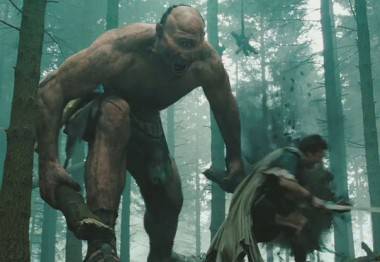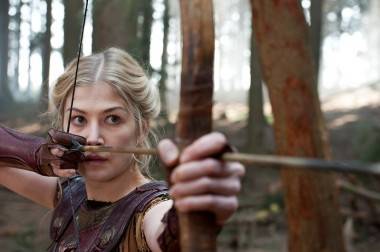Flying dirt and bad CGI – thanks again, Hollywood!
– by Clinton Hallahan
Before talking about Wrath of the Titans, I want to talk about two other films of this decade (because, to be honest, they’re more fun to talk about).
The first film is Pan’s Labyrinth, the labour of love Guillermo Del Toro made with much of his own finances and sheer force of will. The story of a little girl growing up in Civil War-era Spain, the 2006 film is like a kaleidoscope Disney movie, except our orphan-princess surrogate is actually sad, and the events occurring around her are given the appropriate brutality. Plot aside, Del Toro is a stickler for practical magic.
While Peter Jackson had just made history with CG filmmaking in his Lord of the Rings trilogy, Del Toro loaded his actors up with as much gross tonnage of make-up as they could carry. Everything in the world of Pan’s Labyrinth has weight, and feels like a physical part of the world, with all the threat that carries. It makes the fantastic come to life in a very disturbing way.
The other film is Edgar Wright’s Scott Pilgrim Vs. The World, the CG-heavy adaptation of Canadian comic book author Brian Lee O’Malley’s series of the same name. A romance story steeped in the characteristics of a video game, the 2010 movie features a ton of stylized fisticuffs in the film as Scott (Michael Cera) takes on the seven evil ex-boyfriends of Ramona, the object of his desire. In the same summer that gave us its polar opposite in The Expendables, Wright (Shaun of the Dead, Hot Fuzz) proved himself again as one of the preeminent directors of our time with some of the savviest camerawork in years.
While a mediocre script mostly failed it, the hand-to-hand combat scenes in Scott Pilgrim will go down in history as the way forward. While The Expendables brought to its logical conclusion the kind of brawling and martial arts scenes barely discernable through shoddy camera placement and machine-gun edits, Wright’s comic-book/computer-game mashup gave us a kinetic kung-fu movie, with every punch landing with purpose while we could actually follow what was going on.
These, among others, were major events in filmmaking at a time when Wrath of the Titans director Jonathan Liebesman was in Hollywood and presumably paying attention. So why did he learn no lessons?
Wrath of the Titans is the continuing story of Perseus (Sam Worthington), a demigod son of a human mother and Zeus (Liam Neeson), head honcho Greek god and all around diminished badass. After defeating the Kraken in precursor film Clash of the Titans, Perseus is called upon to abandon his son and his quiet life as a fisherman to save his father Zeus from capture at the hands of Hades (Ralph Fiennes) and his other son, Ares (Edgar Ramirez).
While it’s not inaccurate to say that Wrath is a step up from Clash in almost every way, it fails to be any of its many potential movies. It’s a poor exploration of mythology; a poor action film; and, as a character piece with an A-list cast to rival an Oscar-bait production, it fails spectacularly. Trying to mash the dregs of these attempts together doesn’t a film make, but the framework of each is there. If there was a choice made to fully commit to any of those options, Wrath may have been worthwhile.
As you can tell from the synopsis, the cast of Wrath is utterly stacked. Danny Huston, Fiennes, and Neeson represent the classically-trained-actor-looking-for-a-paycheque contingent, while the underutilized Rosamund Pike and the fantastic Ramirez (fresh off his Criteron-worthy mini-series starring as notorious terrorist Carlos the Jackal) represent the young, talented part.
Now, people don’t reference the greatness of classical Greek tragedy for no reason, and the component pieces – death during childbirth, parental preference of one son over another, brotherly betrayal and forgiveness – are all there if the director would just reach out and grab them. With the cast it has, Wrath of the Titans could have been a strong acting showcase. Instead, the cast is given a barely competent script and asked to make it sparkle. It’s terrible waste. Also, Sam Worthington is just… there.
As an exploration of mythology, the film suffers from a lack of ambition. In a movie about all-powerful gods, the climactic showdown shouldn’t be a fist-fight between two humanoids barely discernable as extra-powerful. There is a single scene of gods flexing some power and, in a movie that already borrows (although “steals” might be more accurate) heavily from the vision of gods and titans from the video game God of War, even that devolves into a scene ripped (poorly) from Dragon Ball Z.
But it’s as an action film where the failure is most pronounced. This is where Scott Pilgrim and Pan’s Labyrinth come in (and they’re only examples, not unique in their achievement): the CG and how the action is shot in Wrath of the Titans takes away any power the material might provide.
Movie trailer – Wrath of the Titans (HD):
The film opens with demons attacking a village. Though fight scene has its moments, the enemies are so clearly not a part of our world, so clearly fake, there’s no peril. When Liebsman does decide to keep the camera still long enough to show us what’s going on, we’re underwhelmed because it’s impossible to buy into the danger of the moment. The producers have backed him into a catch-22: use the good camera technique of Wright (or even Liebsman himself in parts of the inexplicable hit Battle: Los Angeles) and put your flaccid CG-wolfdog things on display, or shake it around a lot, obscuring their fakeness and losing the audience in another way.
Like it’s predecessor, WoT is more frustrating than entertaining. It’s not really offensive in any way more than its lack of ambition. A movie about gods and titans messing in the affairs of mortal men should be a no-brainer, especially in a world where CG utilized with tender loving care makes anything and everything possible. Wrath of the Titans is just another numbing agent, another cash-in action film cranked out because the movie-going public will buy pretty much anything with enough flying dirt. If I can say anything positive about Wrath, it’s that the flying-dirt demographic will be pleased as punch. Everybody else will wish they had gone to see The Hunger Games again.



